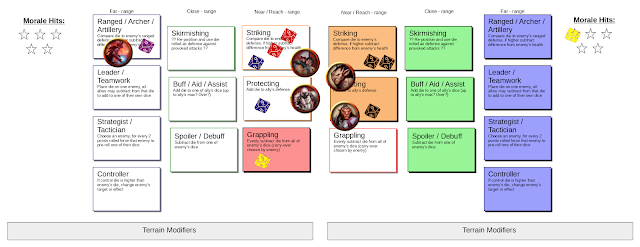Which is what got me thinking: we use a map to show where all the characters are on the field (and move them 5' squares at a time) - what if there was a map of "combat capabilities" that we placed every character on instead? If we mapped the intent of the character instead of (or along with) their position?
Well, first we'd need a list of those "combat capabilities." Roles are too general, I'm thinking of something more specific, that defines a single action and not a general strategy. There needs to be several, and they need to be flexible enough to map all the different kinds of abilities and options in a fight. I came up with 10 groups. I thought about trying to tie this to a specific game system but instead it seems like it might need it's own rules. This is all a very rough idea right now, but here are the categories:
- Grappling - is directly touching the enemy, "man-to-man" so to speak. By default this reduces the effectiveness of everything the enemy is trying to do (since you're getting in the way of their attacking or defending or even thinking by being (possibly literally) on top of them). There could also (and should) be special abilities that can trigger when a character does this type of combat action.
- Striking - is trying to hit the enemy with a melee weapon (or fist, other natural weapon, etc). It's the up-close-and-personal side of fighting, focused on doing damage.
- Protecting - is defense, trying to avoid being hit. This could be either for oneself or an ally, and each action is aimed at a specific enemy (the one you're protecting from).
- Skirmishing - covers throwing weapons, attacking with a reach weapon (thus, over the shoulders of the Strikers and Protectors), or maneuvering yourself outside the battle to get into a better position (ie, to set up a backstab). This is kind of like Striking in that usually you're doing or going to do damage to the enemy, but space/ distance/ positioning is playing an important part of that action.
- Buff/ Aid/ Assist - simply means trying to help an ally with whatever they are doing.
- Spoiler/ Debuff - focuses on hindering an enemy's action (from yelling curses as a distraction to throwing a Tanglefoot Bag at them).
- Ranged/ Archer/ Artillery - the guys who shoot from the farthest distance, with the attendant issues of shooting into melee/ around everybody else.
- Leader/ Teamwork - help focus the efforts of their allies on a specific enemy (calling out maneuvers, or weakness).
- Strategist/ Tactician - watch the battle unfold, seeing what is going to happen in advance - thus reducing the uncertainty of the fight.
- Controller - directs the enemy's actions, or rather re-directs, making the enemy target or do something they did not intend (like hit their buddy).
So we place our combatants on their respective sides...
Each character has a different number of dice (depending on how good they are at fighting), they also use different colored dice...
Now, each character would have different sized dice for each capability (since different characters will be good at different things) - but all I had on hand was the graphic for the d10, so imagine those are actually 4s, 6s, 8s, 10s and 12s (potentially)...
We could even put the miniatures or tokens on the map to show space as well as intent (though, granted, it does crowd the map)...
Above we have our Goblins trying to Grapple with the Axeman while the Hobgoblin makes 2 attacks against the Armored Guy, and puts 1 Protecting die against the Armored Guy's attacks. The Hobgoblin figures the Goblins will be able to bring down the Axeman's attacks enough to make him no threat.
Armored Guy is putting 1 die in Striking and 1 die in Protecting both vs the Hobgoblin, the Axeman is making 2 Striking attacks, both at one Goblin (hoping to take it out). The Mage is warming up a Magic Missile or other ranged attack.
At the end of Round 1 (above), one Goblin is killed, which causes a "Morale Hit" - since for good tactical combat we need to track morale and group cohesion. Someday I'll think of some rules for that :)
Round 2 sees some shifts. The Mage decides to cast a "Shield" or other protective spell on the Armored Guy, the Hobgoblin is fighting with just a longsword, he's going to use his free hand (and great strength) to try to pull the Armored Guy's shield out of the way (Spoiler/Debuff targeting Protection) to deliver a killing blow before the Axeman finishes the last Goblin. Since the Goblin is just cannon fodder, it's going to keep doing the same thing as last turn.
And thus combat would continue. I don't have any solid rules yet, this was a recent idea. But I have to admit, looking at it I kind of like it. I like the way it explicitly lays out what can be done in the fight, where everybody stands in relation to each other. Sure, this kind of thing does exist anyways in how the abilities work - but it can be easy to lose sight of the tactical forest for the action economy trees (at least, it was in the games I GM'd/ Played).
Well, what do you think? Is this an idea that I should work on? Would you like to have something like this for your table? Or am I just being crazy? Please comment below, if anybody wants I'll try to develop this further.








No comments:
Post a Comment